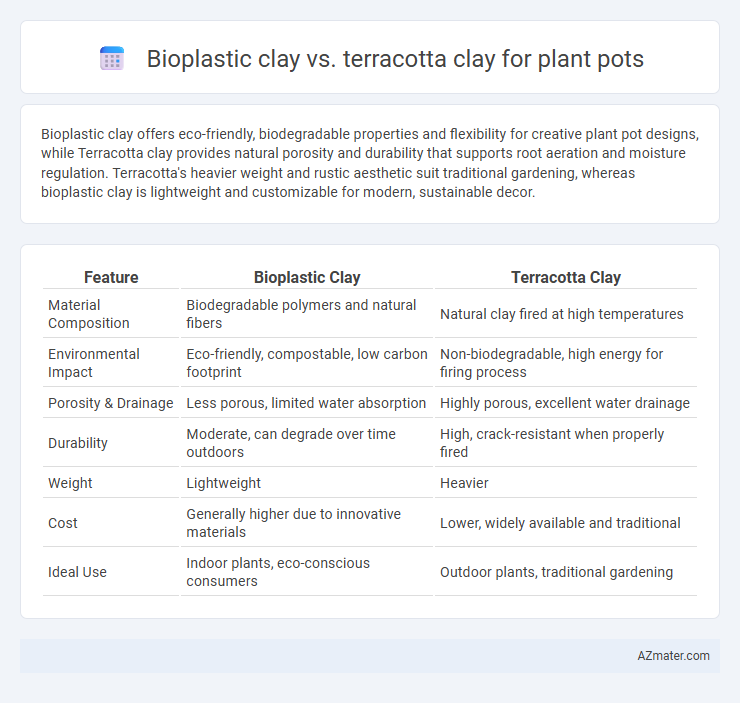Bioplastic clay offers eco-friendly, biodegradable properties and flexibility for creative plant pot designs, while Terracotta clay provides natural porosity and durability that supports root aeration and moisture regulation. Terracotta's heavier weight and rustic aesthetic suit traditional gardening, whereas bioplastic clay is lightweight and customizable for modern, sustainable decor.
Table of Comparison
| Feature | Bioplastic Clay | Terracotta Clay |
|---|---|---|
| Material Composition | Biodegradable polymers and natural fibers | Natural clay fired at high temperatures |
| Environmental Impact | Eco-friendly, compostable, low carbon footprint | Non-biodegradable, high energy for firing process |
| Porosity & Drainage | Less porous, limited water absorption | Highly porous, excellent water drainage |
| Durability | Moderate, can degrade over time outdoors | High, crack-resistant when properly fired |
| Weight | Lightweight | Heavier |
| Cost | Generally higher due to innovative materials | Lower, widely available and traditional |
| Ideal Use | Indoor plants, eco-conscious consumers | Outdoor plants, traditional gardening |
Introduction to Bioplastic Clay and Terracotta Clay
Bioplastic clay is an eco-friendly, biodegradable material derived from renewable resources such as cornstarch and vegetable oils, offering a lightweight and water-resistant option for plant pots. Terracotta clay is a traditional, natural clay fired at high temperatures to create porous, durable pots that allow air and moisture to pass through, promoting healthy root growth. Both materials have distinct properties impacting plant health, with bioplastic clay emphasizing sustainability and terracotta clay providing breathability and temperature regulation.
Material Composition and Origins
Bioplastic clay for plant pots is primarily composed of biodegradable polymers derived from renewable plant-based sources such as cornstarch or cellulose, making it an eco-friendly alternative to conventional plastics. Terracotta clay originates from natural, porous earthenware clay rich in iron oxide, which gives it its characteristic reddish-brown color and excellent breathability for plant roots. While bioplastic clay prioritizes sustainability and compostability, terracotta clay emphasizes natural mineral content and traditional firing techniques that enhance durability and moisture regulation.
Environmental Impact: Sustainability and Biodegradability
Bioplastic clay offers enhanced sustainability by being derived from renewable plant-based materials and exhibiting faster biodegradability compared to traditional terracotta clay, which is made from non-renewable natural clay and requires high-energy kiln firing. Terracotta pots, while durable and porous, have a larger carbon footprint due to mining and firing processes, and their biodegradation is significantly slower in natural environments. Opting for bioplastic clay plant pots reduces environmental impact through lower resource consumption and quicker decomposition, aligning with eco-friendly gardening practices.
Strength and Durability Comparison
Bioplastic clay offers moderate strength and flexibility, making it less prone to cracking under impact but generally less durable in outdoor conditions compared to terracotta clay. Terracotta clay boasts high compressive strength and exceptional durability, resisting weathering, UV exposure, and temperature fluctuations, which makes it ideal for long-lasting plant pots. While bioplastic clay provides lightweight and eco-friendly benefits, terracotta remains superior for structural integrity and extended outdoor use.
Water Retention and Breathability
Bioplastic clay offers superior water retention compared to terracotta clay, making it ideal for plants that require consistently moist soil. Terracotta clay is porous, allowing excellent breathability and promoting aeration for roots, which helps prevent overwatering and root rot. Choosing between the two depends on the specific water needs of the plant and the desired balance between moisture retention and airflow.
Weight and Handling Ease
Bioplastic clay is significantly lighter than terracotta clay, making plant pots easier to move and handle, especially for larger sizes or frequent repositioning. Its pliable texture allows for smoother shaping and customization, while terracotta clay is heavier and more fragile, often requiring careful handling to prevent cracks or breaks. The lightweight property of bioplastic clay enhances portability and user convenience compared to the traditional robustness yet weightiness of terracotta.
Cost and Affordability Analysis
Bioplastic clay for plant pots typically incurs higher upfront costs due to specialized materials and manufacturing processes, whereas terracotta clay offers a more affordable option with widespread availability and lower production expenses. Terracotta pots are renowned for their durability and breathability, contributing to cost-effectiveness over time despite a moderate initial price. Bioplastic pots, while eco-friendly, often require premium pricing, potentially limiting accessibility for budget-conscious consumers looking for affordable plant containers.
Plant Health: Root Aeration and Growth
Bioplastic clay offers limited root aeration compared to terracotta clay, which is porous and allows better oxygen exchange essential for healthy root development. Terracotta's breathable nature prevents waterlogging and promotes optimal moisture balance, reducing risks of root rot and fostering vigorous plant growth. In contrast, bioplastic clay's density can trap moisture and limit oxygen, potentially hindering root respiration and overall plant health.
Aesthetic Appeal and Customization
Bioplastic clay offers vibrant color options and smooth textures, enhancing the aesthetic appeal of plant pots with a modern, eco-friendly look. Terracotta clay provides a classic, earthy charm with its natural reddish-brown hue and porous surface, developing a unique patina over time. Customization with bioplastic clay is easier due to its moldability and color versatility, while terracotta allows for hand-carved designs but has more limitations in shape and color variation.
Choosing the Right Clay for Your Plant Pots
Bioplastic clay offers a lightweight, eco-friendly alternative to traditional terracotta clay, providing enhanced durability and reduced environmental impact for plant pots. Terracotta clay, known for its porous nature, promotes aeration and moisture regulation essential for healthy root growth, making it ideal for plants requiring well-drained soil. Choosing between bioplastic and terracotta clay depends on factors such as plant species, desired pot longevity, and sustainability preferences, ensuring optimal growth conditions and aesthetic appeal.

Infographic: Bioplastic clay vs Terracotta clay for Plant pot
 azmater.com
azmater.com